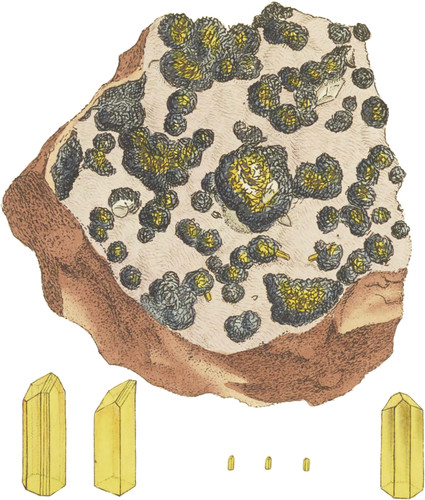 Enlarge
Enlarge
British Mineralogy
Crystallized Oxide of Zinc
- Class 3. Metals.
- Order 1. Homogeneous.
- Gen. 6. Zincum.
- Spec. 1. Oxygenizatum.
- Gen. Char. Light gray, ductile, brittle, Fracture foliated, brilliant; easily fusible, burning with a green flame and soluble in acids.
- Spec. Char. Zinc in combination with Oxygen.
- Syn.
- Zing, mineralized by Oxygen. Kirw. 2. 233.
- Galmei. Emmerl. 2. 454.
- Zinc oxydé. Haüy, 4. 159.
- Calamine ou Pierre Calaminaire. De Lisle, 3. 79.
Having figured Blende or Sulphuret of Zinc, tab. 74 and 75, we are glad to add perfect crystals of the Oxide of Zinc. It was sent by Earl Ferrers, from his mines in Leicestershire, to Miss Codrington, and enriched that Lady's collection of minerals, who discovered these beautiful crystals. It is the only specimen that has yet been noticed; and we cannot help mentioning that lady's generosity in allowing us to examine it with every freedom. I thought it of much use to figure and describe it as well as was practicable from the little that can be spared from the specimen, which altogether does not contain more than a grain or two at the most. It consists of beautiful topaze-coloured crystals dispersed about the specimen, some of which are too small to be seen without the help of a lens: others, however, may be seen without one, three in particular, as figured. Hitherto crystals of Oxide of Zinc have been but little noticed in Great Britain. Mr. Smithson, in Phil. Trans. for the year 1803, part i. 17. after speaking of a yellowish Calamine from Derbyshire not electric, says of Electric Calamine—“that the Abbé Haüy has considered this kind as differing from the other Calamines only in the circumstance of being in distinct crystals; but it has already appeared, in the instance of the Derbyshire Calamine, that all the crystals are not electric by heat, and hence, that it is not merely to its being in this state that this species owes the above quality. And the following experiments on some crystals of electric Calamine from Regbania in Hungary, can leave no doubt of its being a combination of Calx of Zinc with Ouartz ; since the quantity of Quartz obtained, and the perfect regularity and transparency of these crystals, make it impossible to suppose it a foreign admixture of them. They were not scratched by a pin; a knife marked them.
“According to Pelletier’s* experiments on the Calamine of Fribourg in Brisgaw, which is undoubtedly of this species, its composition is :
| Quartz | 0.50 |
| Calx of Zinc | 0.38 |
| Water | 0.12 |
| 1.00 |
and according to his own experiments:
| Quartz | 0.250 |
| Calx of Zinc | 0.683 |
| Water | 0.044 |
| Loss | 0.023 |
| 1.000 |
“The water, he observes, is most probably not essential; and in that case, from his experiments, it would be:
| Quartz | 0.261 |
| Oxide of Zinc | 0.739 |
| 1.000 |
“He also says he has found this species of Calamine among the productions of Derbyshire in small brown crystals, &c.; and their form seems, as far as minuteness and compression together will allow of judging, nearly or quite the same as those of Regbania; and the least atom of them on being heated immediately evinces their nature by the strong electricity it acquires. On their solution in acids they leave Quartz.”
When we first looked at this specimen, not having seen such before, we did not know what it was; but on trial with the blowpipe, as it passed into flocculi and dissipated, we soon determined it; nor did we consult any author, until we had made sketches of the crystals, when we were not a little pleased to find our observations agree with those of others as to the form of them. There are some additional facets not mentioned in Haüy, which, although very minute, were sharp enough to be discerned. It is very curious to see a small portion gently warmed, how readily it attracts a few scrapings of paper which cling to it for some time.
These little elegant crystals stand on a gangue of red Sulphate of Barytes crystallized on the surface in little plates of a pinkish colour, modified something like tab. 96, bottom figure. There are some blotches of marle mixed with the gangue. We also find, on the surface, Sulphuret of Zinc and Sulphuret of Copper in somewhat irregular groups of crystals; the first of a gray colour, the latter of a golden hue, and almost in tetraëdrons. There are some nearly metastatic crystals of Carbonate of Lime, and a few crystals of Galæna.
- * Journal de Physique, vol. 20. 434.

